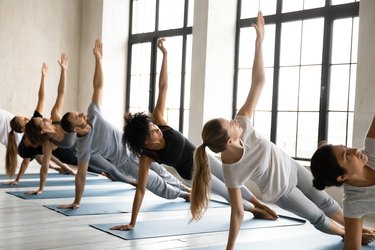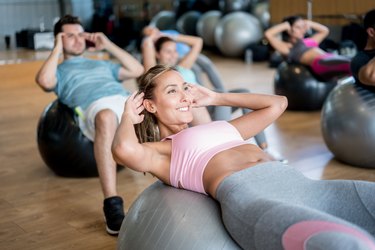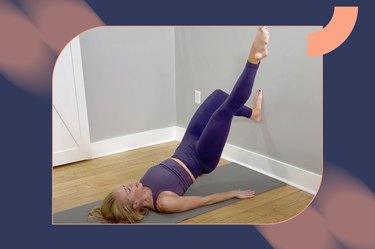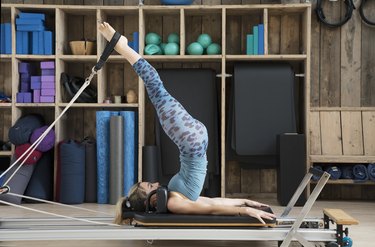
Developed more than 100 years ago for dancers, Pilates has continued to grow in popularity. You can do it on a mat or on a machine called a reformer, which has straps, a sliding carriage with springs and a pulley system. Pilates is low-impact and consists of flowing movements, similar to yoga, that focuses on total-body strengthening with an emphasis on core or abdominal strength.
Pilates has many benefits, including improving strength, flexibility, muscle tone (the tension in a muscle at rest) — and yes, it can even help you lose weight. How quickly you drop pounds, however, can depend on several factors. Find out how to maximize weight loss with Pilates (if that's your goal) along with these top five fat-burning moves.
Video of the Day
An Important Note About Weight Loss
The science of weight management is rapidly changing, and weight loss is more nuanced than “eat less, exercise more.” Yes, cutting and burning calories is a key component of weight loss, but there's much more to it. Your ability to lose weight can be influenced by a wide variety of factors, including your genetics, sleep quality, insulin resistance, hormones, gut health and how you manage stress.
Talk to your doctor before you make any big changes to your exercise routine (or diet). They can help you determine if your weight-loss plan is healthy and appropriate for you based on your medical history, health status and medications.
Is Pilates Good for Weight Loss?
To lose weight, you need to burn more calories than you take in by doing exercises, cutting calories — or ideally doing both (safely!). Pilates does burn calories, but not quite as many as higher-intensity exercises like running. It does have plenty of other benefits, however, that can equate to weight loss, especially when you stay consistent with it.
"Pilates is a full-body movement exercise that strengthens the muscles throughout the body," says certified Pilates instructor Amy Ulmer of INLINE Pilates + Fitness. "Building lean muscles will burn fat, which promotes weight loss."
Pilates uses body weight or, when using the reformer machine, lower weight with high repetitions which improves strength, endurance and muscle tone.
What Does the Research Say About Pilates for Weight Loss?
A small June 2016 study in the Journal of Physical Therapy Science looked at 36 middle-aged women and found that after 12 weeks of Pilates three times per week, they had improved body composition and had less fat in their midsection.
The benefits of Pilates apply to an older population as well. A January 2014 study in Clinical Interventions in Aging looked at 303 women over the age of 60 and found that Pilates did help them lose weight and increase lean muscle mass. However, for best results, it needed to be done along with cardiovascular activity (such as brisk walking, running, or cycling) four to five times a week.
Even though more studies on Pilates need to be done on a larger population, the science appears promising. The key to weight loss is burning calories. If you enjoy Pilates and do it on a regular basis, it will help you lose weight.
How Many Calories Does Pilates Burn?
There are several factors to consider when determining how many calories Pilates burns. It depends on the intensity of the class (beginner versus advanced, for instance), your current weight and if you're doing mat Pilates or reformer Pilates.
According to the American Council on Exercise (ACE), if you are a 150-pound person, you will burn around 175 calories during a beginner-level mat Pilates class for 50 minutes. If you do an advanced-level class, you will burn around 254 calories.
Pilates on the reformer machine can burn more calories than mat Pilates as it uses more resistance.
"Mat Pilates relies solely on your body weight to create the resistance," Ulmer says. "Reformer offers a spring system as the resistance. You can utilize the springs to make certain moves more challenging."
To compare calories burned with Pilates to other forms of exercise, a person of similar size after 30 minutes would burn 175 calories walking, 252 calories cycling, 360 calories running a 10-minute mile and 421 calories jumping rope, according to Harvard Health Publishing.
Reducing exercise to nothing more than calories can lead to restrictive or disordered behaviors. You can be sure you're making the best choices for your health when you do a physical activity you enjoy.
How Often Should You Do Pilates?
You may be wondering, is 20 minutes of Pilates a day enough to lose weight? According to Ulmer, your Pilates sessions should actually last a bit longer to see results.
"Pilates is the perfect addition to your workout routine," Ulmer says. "I would suggest two to three times a week for at least 45 minutes."
Is Pilates alone enough exercise? As recommended in the Clinical Interventions in Aging study above, you should also do higher-intensity cardio, such as cycling, running or HIIT four to five times a week for at least 30 minutes for an added cardiovascular boost.
Whichever type of exercise you do, aim for 150 minutes of moderate-intensity aerobic activity per week, which breaks down to 30 minutes per day over five days, according to the Centers for Disease Control and Prevention (CDC).
5 Pilates Exercises to Add to Your Routine
Ulmer says the following five mat Pilates moves she demonstrates below will work all your major muscle groups and burn calories.
1. The Hundred
"The Hundred sounds intimidating, but is a great total-body move," Ulmer says. It not only strengthens your core muscles but also your upper body (deltoids) and lower body (quadriceps and gluteal muscles).
With this exercise, you inhale for 5 seconds and exhale for 5 seconds while performing the move. That is one set. You do that 10 times and that equals 100, hence the name. It's often done at the beginning of a Pilates class because it's a great warmup move.
- Lie on your back with your knees bent and feet flat on the floor, arms at your sides.
- Bring your knees up into tabletop position so they are bent to 90 degrees.
- Raise your head and shoulders off of the mat with your chin pointed down.
- Straighten your legs out, at about a 45-degree angle. You can adjust them higher or lower, as long as your lower back stays planted into the floor.
- As you straighten your legs out, lift your arms a few inches off the mat and extend them out straight.
- Inhale in for 5 seconds and exhale for 5 seconds. As you do this, pump your arms up and down in small and controlled movements.
- Do 10 cycles of inhaling for 5 seconds and exhaling for 5 seconds.
- If you feel like you can’t keep your back flat or if your back starts to hurt, you can move your legs back into tabletop while doing this.
- After doing 10 sets, return to your starting position.
2. Leg Pull Front
This Pilates move does it all: It strengthens your abs, shoulders, calves, glutes, hamstrings, quads and arms.
- Start on all fours with your wrists underneath your shoulders and knees under your hips.
- Move into a high plank position by lifting your knees off of the ground and keeping your body in a straight line.
- Lift your right leg off of the floor until it's even with your body. Don't let your trunk rotate.
- Hold for 5 seconds.
- Repeat with the other leg.
- Continue 10 times on each side for a total of 20 reps.
3. Hip Twist
This is an excellent move for strengthening your entire core, especially the oblique muscles along the sides of your torso.
- Start by sitting on the mat, resting on your elbows with your knees bent and your feet flat on the floor.
- Roll back slightly and lift your legs off the ground and straighten them in front of you.
- Circle your legs in one direction, keeping the movements slow and controlled.
- Circle them in the other direction.
- To make this more challenging, you can come up on your hands with your fingertips pointing back.
- Repeat 5 to 10 circles in each direction.
4. Kneeling Side Kick
This move works your torso, arms and hip muscles.
- Start by kneeling on both knees.
- Place your left hand on the mat underneath your shoulder.
- Extend your right leg straight out.
- Place your right hand behind your head.
- Lift your right leg off the mat until it's straight out and in line with your body.
- Kick it forward until it's straight out in front of you.
- Continue moving your right forward and backward 12 to 15 times while keeping your torso stable and not letting it twist.
- Repeat on the other side.
5. Boomerang
The Boomerang is an advanced, high-energy Pilates move that not only strengthens your core, back extensors and hips, but also improves overall flexibility.
- Start by sitting on the mat with your ankles crossed.
- Fold forward reaching toward your feet as you feel a stretch along the back of your legs.
- Roll your spine down the mat, as you lift your legs overhead and straight behind you.
- Cross your legs one time.
- Roll your spine back down as you straighten your arms in front of you.
- Hold with your legs up and your arms in front, feeling your core tighten.
- Bring your arms behind you as you clasp your hands behind you.
- Move your arms up and over your head.
- Repeat 2 to 5 times.
The Bottom Line
So, does Pilates help you lose weight? Pilates is a low-impact workout that strengthens your entire body, improves flexibility and even helps reduce stress. Although it doesn't burn as many calories as higher-intensity exercises like running, studies have found that when done consistently it will help you lose weight and increase lean muscle mass. For best results when trying to lose weight, do Pilates two to three times a week, along with higher-intensity cardio, while also maintaining a healthy diet.
- Journal of Physical Therapy Science: "Effect of Mat Pilates Exercise on Postural Alignment and Body Composition of Middle-Aged Women"
- Clinical Interventions in Aging: "24-Weeks Pilates-Aerobic and Educative Training to Improve Body Fat Mass in Elderly Serbian Women"
- American Council on Exercise: "Can Pilates Do It All?"
- Harvard Health Publishing: "Calories Burned in 30 Minutes for People of Three Different Weights"
- Centers for Disease Control and Prevention: "Physical Activity for a Healthy Weight"
Was this article helpful?
150 Characters Max
0/150
Thank you for sharing!
Thank you for your feedback!


